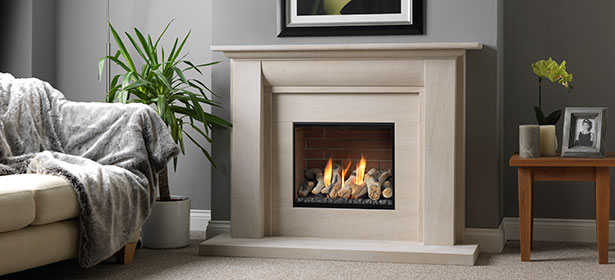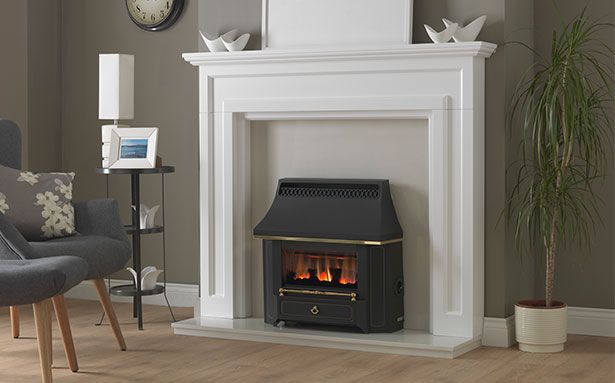Complete guide to buying a gas fireplace

Gas fires offer an efficient and convenient alternative to wood burning stoves.
They can generate a lot of heat, and gas is cheaper than electricity per unit of energy. However, they won't generate heat as efficiently central heating powered by a gas boiler. As with all gas appliances, gas fires must be installed by a Gas Safe-registered engineer.
Our guide covers everything you need to know about buying the best gas stove for you, from installation and running costs to servicing and maintenance, and more about their environmental and health impacts.
If you're considering other options, check out our guide to how to buy the best electric fireplace
What is a gas fireplace?
Gas fireplaces connect to your mains gas supply, and burn that gas to produce heat.
Most gas fireplaces are designed to look like wood burning stoves. However, they are much easier to use: all you need to do is switch on the device, and you can turn the heat up and down depending on your preference.
They are an efficient and low maintenance way to heat a single room, and they can add a cosy ambience to your space.
Types of gas fire
There are a few different types of gas fire:
- Inset vs outset: Inset models sit inside your fireplace, or even in a hole in the wall, while outset models sit on the hearth or are wall-mounted.
- Glass vs open-fronted: Glass models sit behind a fixed panel. They are typically a little more efficient than open-fronted fires, but they require some cleaning.
- Fuel bed: This is what appears to be burning when the fire is on. They include logs, coal or stones.
Gas fireplace heat output and efficiency
A gas fire can easily produce enough heat to function as the only source of heat in a single room, because they are so efficient.
However, the efficiency of your gas fire will depend to an extent on the flue type.
Flueless gas fires (which have a catalytic converter instead of a flue) and balanced flue gas fires (which vent through an external wall) can provide heat efficiencies of up to 90%, according to the Heating and Hotwater Industry Council. This means they convert 90% of the fuel into usable heat.
If you have a chimney, you can opt for a fire with a conventional flue (which releases combustion gases up the chimney). However, these also lose a lot of heat due to the chimney - they run at around 50-70% efficiency.
Gas place vs central heating
If you want to heat multiple rooms at once, central heating is more efficient than a gas fire.
However, if you want to heat a single room, central heating may not be the most efficient solution.
This will be determined by your boiler and set-up: if you have a modern boiler, and you can zone your central heating (so you can control the temperature of different rooms individually), this is likely to be more efficient.
But if you have an older boiler, or you can't zone your heating, your gas fire will be much more efficient.
What size gas fire do I need?
Approximately speaking, to make your room 21°C when it’s 1°C outside, you’ll need 1kW of heat output for every 14 cubic metres of space.
As a rough guide, multiply the height, width and length of your room in metres to calculate the size of your room in cubic metres. Then divide this by 14 to calculate the kWs you will need.
For example, if your room is 3.5m wide, 5.5m long, and your ceilings are 2.5m high, then the volume of the room is 48 cubic meters.
You need 1kW output for every 14 cubic meters - 48 divided by 14 is 3.4.
This means you would need a 3-4KW gas fire.
Other factors can affect the output you’ll need, such as the level of insulation and number of windows in your home. Consult an installer or retailer for more tailored advice about what suits your property.
Gas fire unit cost
To find out more about how much real owners typically spend on their gas fire (and how satisfied they are), in 2024 we asked 39 Which? readers who bought an gas stove in the last 5 years to tell us more about their experience.
Log in or join Which? to see how much they report spending on their gas fireplace unit.
Gas fire installation and installation costs
In the UK, all gas products must be installed by Gas Safe registered engineers.
The engineer should also check that the chimney, flue or vent system you’ll be using is suitable.
Use Which? Trusted Traders to find Gas Safe engineers who have passed our rigorous assessment process and follow our code of conduct.
Gas fire installation costs
The cost of installing a gas fire varies massively depending on the type of fire you install.
Balanced flue stoves, which require a hole through an external wall, are most expensive. The cost of installation will also increase if you do not have an existing hearth.
Log in or join Which? to see how much our readers report spending on installing their stove.
Gas fire running costs
To calculate a very rough running cost for a gas fire, you need to multiply the output in kWs by the price of gas in kWs.
For example, between October and December 2025, the Ofgem gas price cap is 6.29p per kW. So it would cost 31.45p to run a 5kW gas stove for an hour at full power.
However, this assumes your stove is running at full efficiency – which is not possible. Here are some running costs for different stove efficiencies for a 5kW stove.
| Stove efficiency/ type | Hourly cost | Daily cost | Monthly cost | 6 Monthly cost |
|---|---|---|---|---|
| 90% efficiency (flueless) | 35p | £1.05 | £31.45 | £190.80 |
| 75% efficiency | 42p | £1.26 | £37.74 | £228.96 |
| 50% efficiency (conventional flue) | 63p | £1.89 | £56.61 | £343.43 |
Note: Assumes three hours of use per day and a 30 day month. Six month cost assumes 182 days of use (to reflect daily use between 1 October and 1 April).
You can calculate the running cost of your stove by dividing the output in kW by the efficiency of the stove – to create the input required in kW – and multiplying this by the gas price.
To get a better sense of how much it costs to use a gas fire, we asked our readers if they feel their fire is too expensive to run, and whether or not they use their heating less since having the fire installed.
Log in or join Which? to see what they said.
Read our expert reviews of the best carbon monoxide detectors to find out which carbon monoxide alarms passed our safety tests.
Are gas fires safe?

Burning gas produces poisonous chemicals, including nitrogen, carbon dioxide, and carbon monoxide. They can irritate your throat, eyes and lungs. In high quantities, they can be fatal.
However, if properly installed in a well ventilated room, these chemicals are either pumped outdoors or cleaned inside the unit (depending on the type of stove you own). In addition, modern gas fires produce less of these chemicals during combustion.
If your gas fire is properly installed and maintained, it will be almost completely safe.
Monitoring your gas fire
If you live in Scotland, you are legally required to have a carbon monoxide dector in the room with your gas fire. In the rest of the UK it is highly recommended.
Carbon monoxide is tastless and does not have a scent, so you will not know if your gas fire is releasing carbon monoxide into your room. However, this gas is very poisonous and can be fatal.
You could also consider purchasing a gas fire with an oxygen depletion sensor. These automatically switch off the gas supply if oxygen levels drop, to avoid producing dangerous levels of carbon monoxide.
Gas fire servicing
As with all gas appliances, you should get a qualified Gas Safe engineer to check your fire or stove every year to make sure it’s safe to use. You should factor this into your consideration of running costs.
If you’re using a chimney or flue, you also need to get it cleaned regularly to make sure it’s kept clear of blockages.
You should schedule one of these cleans to take place in late summer or early autumn before you first start using your fire or stove.
Are gas fires bad for the environment?
Yes, the gases produced when natural gases are burnt are bad for the environment.
They are also known as greenhouse gases, which contribute significantly to global warming.
In addition, the process of extracting gas from the ground is highly energy intensive and disruptive to the natural environment.
Will gas fires be banned?
The UK government does not have any plans to phase out gas fires.
However, it is phasing out the installation of gas and oil boilers - indicating a general shift away from burning fossil fuels to produce energy.
Another option – albeit a less aesthetically pleasing one – is to buy a portable electric heater. Check out our reviews of the best electric heaters.
Gas fire pros and cons
The main pros of gas fires are the efficiency, and the main downsides are the higher upfront costs.
Pros of gas fires:
- Efficiency: gas stoves are highly efficient, and will comfortably heat a single room
- Ambiance: these stoves have the appearance of a real flame
- Easy to use and high control over temperature: it is quick and easy to adjust the temperature of your stove. You also don't have to clean it often.
Cons of gas fires:
- Upfront costs: you will need to pay for your unit and for it to be installed by a registered engineer, which can be pricey
- Yearly servicing: gas stoves need to be serviced yearly, which can be costly and inconvenient
- Environmental impact: burning fossil fuels does have a negative impact on the environment
- Safety risks: there will always be some risk associated with the use of gas appliances, but these can be mitigated by proper installation and maintenance
Are gas fires worth it?
To find out if gas fireplace owners feel their stoves are worth the price, we asked 39 Which? readers who own a gas stove if they are satisfied with their purchase.
Log in or join Which? to see the percentage of our readers who are satisfied (and dissatisfied) with their stoves.
Gas fireplace FAQs
Do gas fires need a chimney?
No, gas fires do not need a chimney.
You can now buy flueless gas fires, which do not need any external connection. You can also buy balanced flue systems, which only need a hole through an external wall.
Can I hang a TV above a gas fireplace?
If possible, you shouldn't install a TV above a gas fire. This is because the heat can damage your TV.
It might be possible to do so, provided your stove isn't too powerful and your TV is far enough away from the unit.
You should consult with the engineer installing your stove before you add a TV above it.
What are the downsides of a gas fireplace?
The main downside of gas fireplaces is the high upfront costs - you need to pay for the fireplace, and for it to be installed by a gas safe engineer.
You will also need to pay for your gas fire to be maintained, as it needs to be serviced annually.
There is also always an environmental impact and safety risk to burning fossil fuels.
This article uses insights from the Which? Connect panel, collected from research activities with our members. Find out how to get involved







